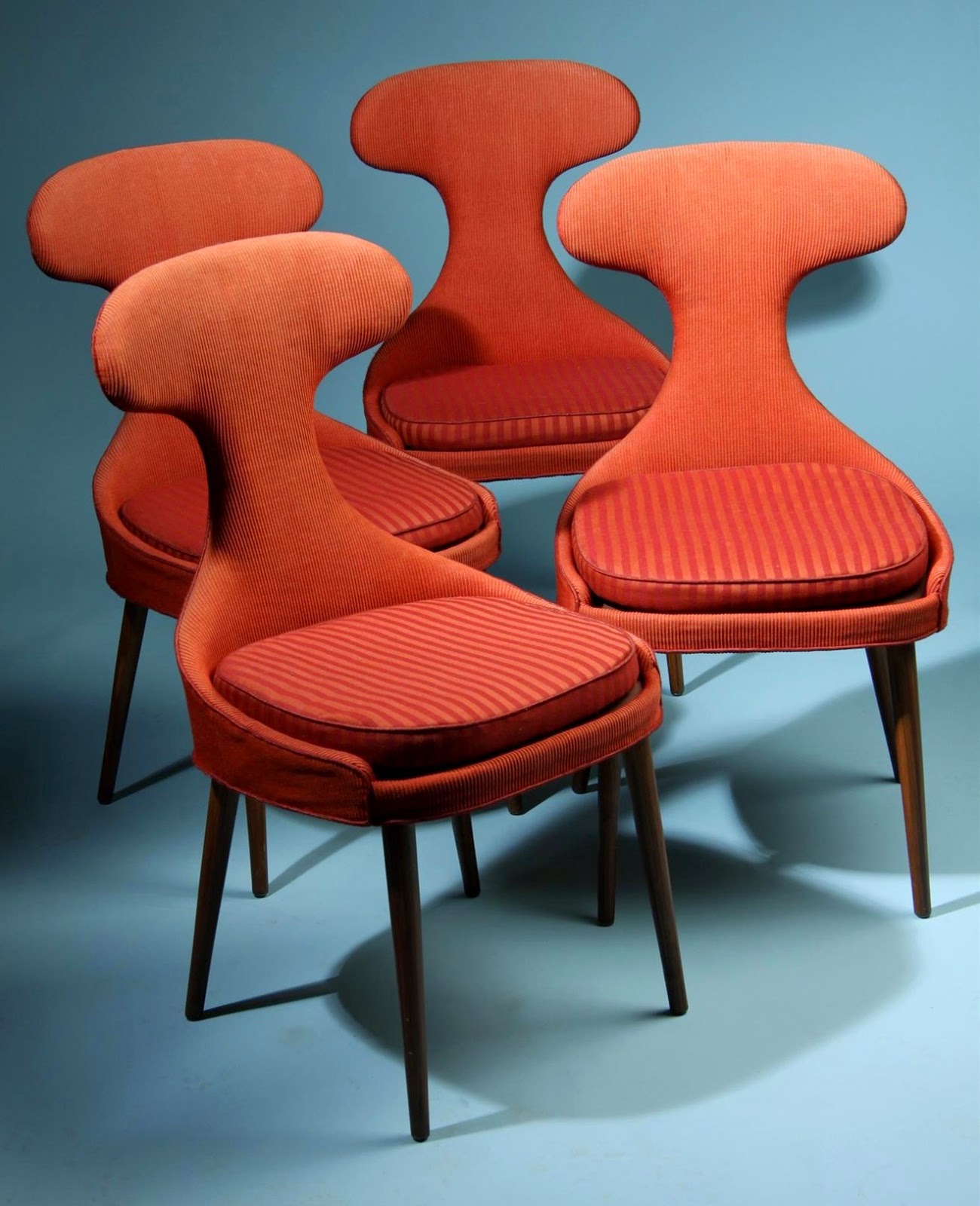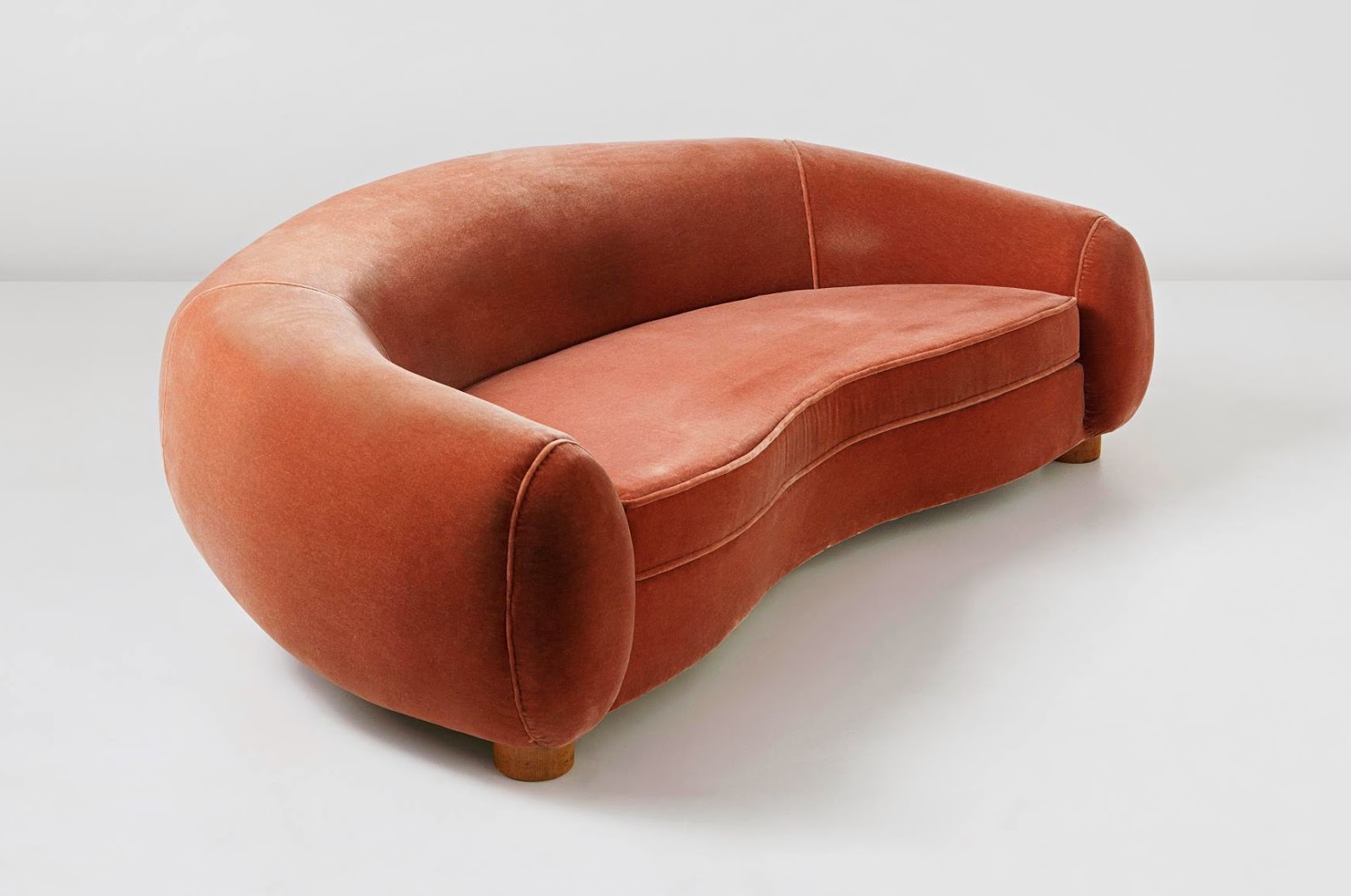Original photo of the 'Tired Man' easy chair upholstered in sheepskin (made by A.J. Iversen).
Flemming Lassen's intention with this huge chair was to make you sit "as warmly and securely as a polar bear cub in the arms of its mother in the midst of the ice cap". Due to the rarity of this chair (only 20-30 were ever made) I haven't tried sitting in it myself but by the sole look of it I'm quite sure the chair furfills Lassen's intention.
Unfortunately record-breaking sales like this also means that several particular chairs that could previously be bought through private Danish adds at no more than $300 are now virtually unattainable and will immediately be snatched up by dealers and sold at auction, simply because they have the right ‘look’.
Nevertheless, let’s forget the money for a few minutes
and look at the goods. I’ve picked examples of my favorite furniture pieces from
the genre.
‘Pelican’ chair designed by Danish architect Finn Juhl
for cabinetmaker Niels Vodder (1940).
This chair is now produced by Danish furniture manufacturer, One
Collection, but was
originally made in only 4 examples for the annual
Cabinetmaker’ Guild in Copenhagen
– 2 in dark red fabric and 2 in black leather.
'Little Petra'
for master cabinetmaker A. J. Iversen
(1938).
'Clam' chairs by Danish architect Philip Arctander for
Nordisk Stål & Møbelcentral (c. 1944).
The interesting story of how this particular chair was wrongfully attributed by
the entire auction world to a Norwegian furniture shop but eventually correctly
identified by the Danish auction house Bruun Rasmussen can be read here:
'Baker sofa' designed by Danish architect Finn
Juhl for American company Baker Furniture (1951).
Equally beautiful from the back!
'Lustgården' chaise lounge designed by Swedish
architect Kerstin Hörlin-Holmquist
as part of her 'Paradiset' series for Nordiska
Kompaniet (1958).
Settee by Swedish designer Elias Svedberg for Nordiska
Kompaniet (c. 1947).
'Samspel' sofa designed by Swedish architect Carl
Malmsten for O.H. Sjögren (late 1940s).
Armchairs, model no. 1669, made by Fritz Hansen (1938).
Armchairs designed by Italian architect Gio Ponti for
the first class ballroom
on the 'Augustus' transatlantic ocean liner. Made by Cassina
(1950).
Unique armchairs designed by Danish architect Arne Jacobsen for the office of brothers
Thorvald & Harald Petersen, the founders of Novo Therapeutic Laboratory, in 1935.
These chairs were originally part of a seating group which also included a third chair and a sofa.
All three chairs have been sold at auction, the pair above fetching $75.000, while the sofa today
remains in the possession of the family after the founders of Novo. I would love to see that sofa!
Extremely rare chair by Danish architect Magnus
Stephensen
and made by master cabinetmaker A.J. Iversen (c. 1940).
Set of dining chairs by unknown designer (likely of
Scandinavian origin).
'Big Eva' chair and stool designed by Swedish
architect Kerstin Hörlin-Holmquist
as part of her 'Paradiset' series for Nordiska
Kompaniet (1958).
Extremely rare 'L’Ours Polaire' (aka 'Polar Bear')
sofa created by French designer Jean Royére (c. 1952).
This is one of the most desirable pieces of modern
furniture selling fetching up to $200.000 at auction!
'Floating Curve' sofa by American architect Vladimir Kagan for Kagan-Dreyfuss Inc. (1952).
Finally, I’d like to show you my all time favorite
piece of furniture in this genre. A nameless sofa
designed by Finn Juhl and
made by Niles Vodder for the Cabinetmaker’s Guild exhibition in 1939.
The first time I saw this weird looking sofa –
probably in my early 20’s – I was literary
shocked of just how downright awkward it looked. I shook my head in utter
disapproval, not taking it the least seriously and actually thinking of it as
being a complete joke. Furthermore I couldn’t get my head around why Finn Juhl
– the creator of such elegant perfection like the NV45 chair – would create this clumsy monster of a sofa.
Today, I absolutely love it for all the exact reasons
that I originally hated it. Esthetically it’s still a mystery to me and so I’m
continuously intrigued by its wonderful free-flowing lines and slightly unbalanced
appearance.
Whether this sofa still exist somewhere is anyone’s
guess. The same goes for the easy chair and the radio in the picture above. They all seem to
have disappeared without any trace after the exhibition in 1939. There’s no
doubt that should especially the sofa suddenly surface and be placed up for
auction, it would probably break every sales record for a modern piece of
furniture.
I very much wanted a easy chair for my living room
that somehow echoed the look of the furniture pieces shown above (especially
since I can’t afford any of them). Though, as I really like wood, I wouldn’t
mind finding a chair with a stronger presence of wood than just the typical small,
choppy legs. So what I perhaps really wanted - or dreaming of, to be precise -
was a chair that had a softly curved seat with buttons so typical of the 1940’s
but with a wooden frame pointing towards the more angular 1950’s. Yeah, a kind
of hybrid chair caught between two different eras that however still share a
lot of esthetical similarities. But hey, dreaming is the easy part - finding
the right chair that somehow resembles what you’ve been imagining free of any
restraints from the real world can take years. If it will ever happen.
I browse through the Danish auction site, Lauritz.com,
every day. Mostly just the categories for modern furniture and design. I seldom
bid on anything as I mostly get my stuff elsewhere but it’s interesting to see
the rare items that sometimes surface and what the market is willing to pay for
them.
A few weeks ago I stumbled across this chair on
Lauritz. While the name of its designer or manufacturer was unknown, it
definitely had the right lines.
I immediately liked it. It was put up for auction at a
showroom in Helsingborg , Sweden Copenhagen
So, it was with quite an uneasy feeling that I bad on
the chair and fortunately won it (not cheap!). When it finally arrived at my
doorstep I was happy to discover that while the seat itself is worn out beyond present
usability - which I knew before I bid - the wooden frame has no damage in the
form of nicks, cracks, loose joints etc. Just loads of dust and surface
discoloration.
I will eventually have the chair completely
restored and I’m absolutely sure it will look fantastic.
+1.jpg)











.jpg)










Hi Martin, this might be an old post, but anyways just to let you know the chair is made by my grandfather Magnus L. Stephensen the same designer who made the extremely rare wing chair.
ReplyDeleteWould love to see it after your renovation :-)
Br. Magnus Stephensen (magnus@stephensen.dk)